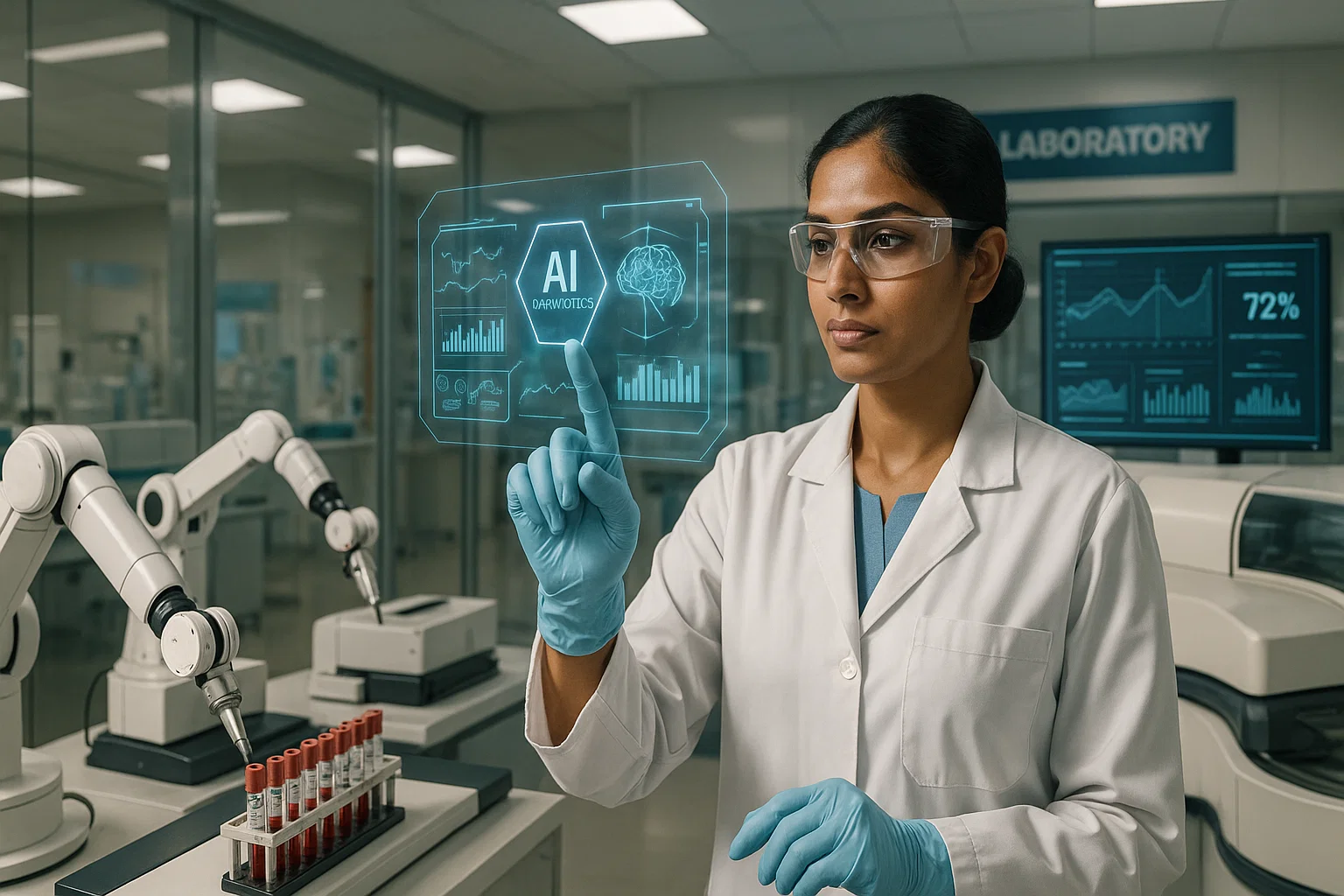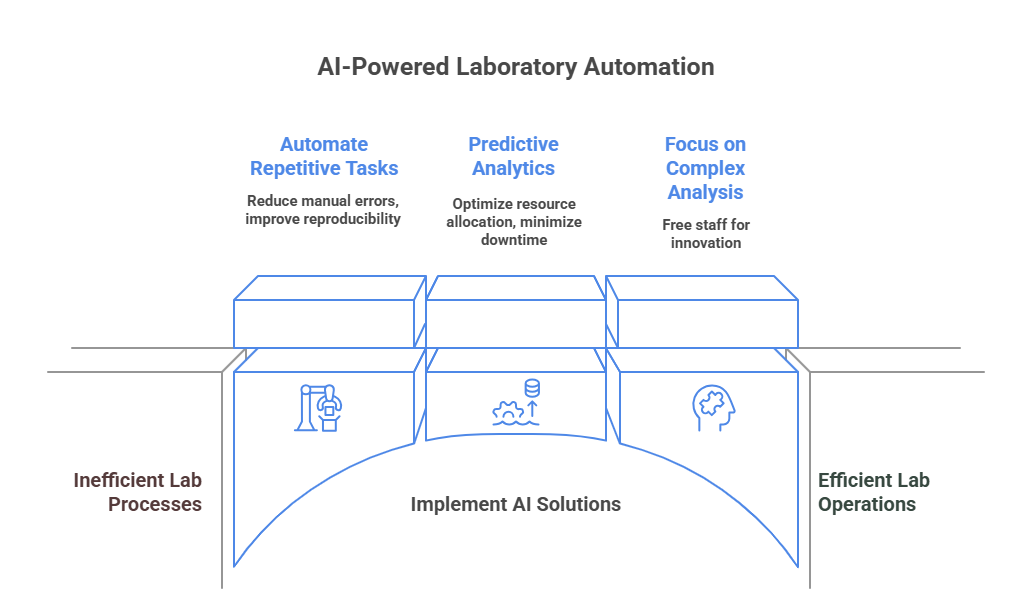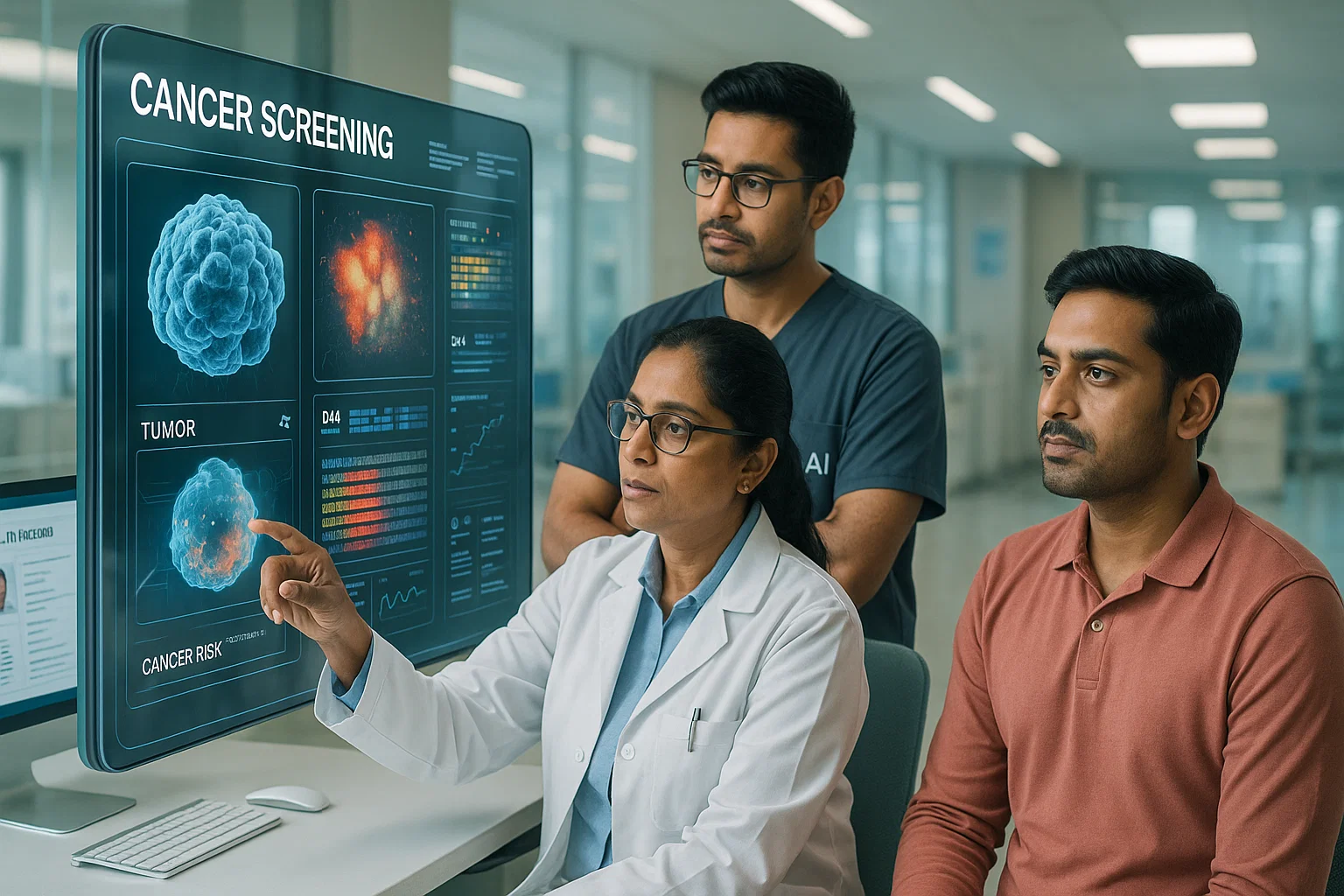
How Artificial Intelligence Can Transform Laboratory Automation
Author: Joyneel Acharya
Last Updated On: 14th November 2025
We've all been there: staring at spreadsheets full of lab data, feeling overwhelmed by the sheer volume, and knowing that one tiny manual slip could set a project back weeks. It's a universal challenge in the scientific world, but what if we told you there’s a way to move past those static, error-prone systems? Artificial intelligence (AI) is here to revolutionize laboratory automation, enabling adaptive, data-driven workflows that are simply impossible with older technologies.
AI isn't just a buzzword; it’s a necessity. By integrating AI into our labs specifically with systems like Laboratory Information Management Systems (LIMS) and Electronic Laboratory Notebooks (ELNs) we can unify instruments and datasets, ensuring seamless interoperability and clean data flow for smarter experimental design and real-time quality control. NirogGyan, for instance, operates a Software-as-a-Service (SaaS) platform offering automated, white-label reporting that seamlessly integrates with existing Lab Information Systems (LIS). This transformation is essential if we want to accelerate research cycles, enhance accuracy, and dramatically reduce human error.
Key Takeaways
- Artificial intelligence (AI) revolutionizes laboratory automation by enabling adaptive, data-driven workflows that surpass traditional static systems, enhancing accuracy, reducing human error, and accelerating research cycles.
- AI-integrated Laboratory Information Management Systems (LIMS) and Electronic Laboratory Notebooks (ELNs) unify instruments and datasets, ensuring seamless interoperability and clean data flow for smarter experimental design and real-time quality control.
- AI addresses growing lab complexity by managing high-dimensional data, optimizing resource use, enabling predictive maintenance, and improving workflow flexibility and scalability, which traditional automation cannot efficiently handle.
- Intelligent automation combines AI with robotics and software, allowing dynamic decision-making and execution of repetitive tasks with precision, supporting faster, error-reduced processes and timely actionable insights.
- Key AI applications include predictive analytics, automated sample handling, real-time anomaly detection, intelligent scheduling, and AI-driven diagnostics, which collectively maximize efficiency and innovation in research and clinical laboratories.
- By embracing AI, laboratories can overcome workflow bottlenecks, ensure compliance and reproducibility, and prepare for future advancements in intelligent automation, maintaining competitiveness and scientific excellence.
Understanding the Need for Artificial Intelligence in Laboratory Automation
The complexity facing modern labs is growing exponentially. We’re dealing with massive data volumes that traditional laboratory automation systems just can’t handle efficiently. Think about it: fixed programming won’t cut it when you need flexibility and adaptation. That's why there’s a critical need of artificial intelligence.
AI directly addresses these workflow bottlenecks. Unlike old, fixed programming, AI learns from data patterns, constantly improving accuracy in sample analysis and equipment handling. This adaptability is crucial for labs dealing with diverse experiments and unpredictable variables. We see companies like NirogGyan focusing on transforming opaque diagnostic reports into clear, actionable health insights, which is a key necessity for patient-centric care today.
In my experience, AI becomes the essential brain supporting the laboratory automation muscles. It helps us manage complex, high-dimensional data, enhances workflow flexibility, improves scalability, and allows for quality control through real-time insights. These capabilities prove that reliable ai solutions, like those offered by NirogGyan, which uses visualization and NLP to clarify results, are absolutely essential for any modern laboratory aiming to stay competitive and innovative.
Key Concepts: Artificial Intelligence and Intelligent Automation in Labs

It’s easy to confuse artificial intelligence and intelligent automation. They sound similar, don't they? But understanding the difference is key to leveraging modern automation technology.
Artificial intelligence (AI) is the "thinking" part. It involves machines mimicking human intelligence learning, reasoning, and adapting allowing them to make dynamic decisions.
Intelligent automation, on the other hand, is the combination of AI with robotics and software to actually execute those decisions. It goes far beyond fixed, rule-based automation.
Here’s the breakdown:
- AI's Role: Analyzing complex data patterns and predicting outcomes.
- Automation's Role: Executing repetitive tasks with precision.
- The Synergy: Integrating AI-driven analytics with automated instruments for real-time insights.
Imagine if AI algorithms could instantly interpret culture results and automatically trigger reporting without any human delay. Companies like NirogGyan exemplify this synergy by using their platform to generate "personalized AI-based summaries" and utilize a WhatsApp-based AI Bot. That synergy reduces errors, accelerates processes, and supports our teams with timely, actionable data. By understanding these concepts, we can adopt scalable, flexible ai applications that evolve with scientific demands.
Exploring AI Applications in Laboratory Automation
The range of ai applications in laboratory automation is expanding fast, driving smarter and faster workflows across the board.
We're not just talking about robots moving vials; we're talking about AI directing those robots intelligently. Key uses include:
- Predictive analytics for optimizing experimental design and resource allocation.
- Automated sample handling using AI-powered lab robotics to dramatically reduce manual errors.
- Real-time data analysis enables instant anomaly detection and quality control.
- Intelligent scheduling to maximize equipment utilization and minimize downtime.
- AI-driven diagnostics improving accuracy in clinical labs and drug discovery.
I've seen the power of this firsthand: autonomous labs, like Berkeley Lab’s A-Lab, use AI algorithms not only to manage processes but also to propose new compounds while robotic lab systems prepare and test them. This massively accelerates discovery cycles. Furthermore, the specific ai applications developed by NirogGyan include personalized AI-based summaries and AI Video Reports, which enhance patient and physician interpretation of results.
AI-Powered Lab Robotics: Revolutionizing Routine Tasks
AI-powered lab robotics are transforming the most repetitive laboratory tasks by combining precision with genuine adaptability. These intelligent robots can handle things like sample preparation, pipetting, and equipment operation with minimal human intervention.
What’s the real game-changer? Unlike traditional automation, AI-enhanced lab robotics learn from ongoing experiments, allowing them to improve task accuracy and dynamically adjust protocols.
This means we get:
- Enhanced reproducibility because manual errors are reduced.
- Accelerated throughput with continuous, 24/7 operation.
- Flexibility to manage diverse workflows and complex protocols.
For instance, the autonomous systems provided by platforms like Scispot’s Scibot execute experiments based on natural language instructions, freeing up scientists to focus on innovation and analysis. This shift truly increases reliability in critical lab processes.
Smart Laboratories: Integrating AI for Enhanced Decision-Making
When we talk about smart laboratories, we’re talking about leveraging ai in labs to transform mountains of raw data into concrete, actionable insights. This is done by integrating AI-driven analytics with essential systems like LIMS and ELNs.
This integration ensures seamless data standardization and interoperability, which supports real-time monitoring and automated anomaly detection, reducing human oversight and errors. This is the essence of intelligent automation at the organizational level.
Key advantages include:
- Enhanced diagnostic accuracy through AI-powered data synthesis.
- Dynamic workflow adjustments based on predictive analytics.
- Automated reporting that accelerates decision cycles.
NirogGyan is a prime example of a company making laboratories "smart". NirogGyan's core product, the "Smart Report," translates complex diagnostic test results into clear, visually intuitive, and actionable health insights. This platform achieves its operational efficiency through "100% automated and error-free" report generation, ensured by seamless API Integration with LIS, HIS, or CRM. Imagine if AI algorithms, like those used by NirogGyan for personalized summaries, could analyze complex clinical data instantly, flagging a quality issue the moment it happens or suggesting the most optimized experimental designs before you even start. Embracing smart laboratories means we're combining our human expertise with AI’s speed and precision to tackle data complexity and workflow bottlenecks effectively.
Benefits of Implementing Artificial Intelligence in Laboratory Automation

Why should your organization invest in artificial intelligence? Because the benefits of implementing ai solutions in laboratory automation are significant, tangible, and immediate.
AI boosts efficiency by reducing manual errors in repetitive tasks like sample handling, which massively improves reproducibility. Companies like NirogGyan demonstrate this by offering "100% automated and error-free" report generation. AI won’t just work faster; it’ll work smarter, accelerating workflows crucial for diagnostics and research.
Furthermore, AI's predictive analytics optimize resource allocation and equipment maintenance. This is huge; it minimizes downtime and cuts operational costs, a major bonus for any budget. We can achieve:
- Increased throughput with 24/7 AI-powered operations.
- Enhanced diagnostic accuracy through data-driven insights.
- Reduced operational costs via predictive maintenance.
Ultimately, AI frees our skilled staff from routine duties, allowing them to focus entirely on complex analysis and innovation. NirogGyan's focus on delivering clear reports ensures that doctors save valuable time that would otherwise be spent explaining cryptic results.
Challenges and Considerations in Adopting AI for Labs
Let’s be real: adopting AI isn't just plug-and-play. While the need of artificial intelligence is clear, we must address several significant challenges when implementing new ai solutions.
First, integrating AI with existing, sometimes outdated, instruments and software (legacy LIMS/ELNs) often leads to compatibility issues, making seamless data flow difficult. This struggle is common when introducing new automation technology. However, companies like NirogGyan proactively address this challenge by building their platform for seamless "API Integration with LIS, HIS or CRM".
Second, high initial costs and the need for specialized personnel to develop and maintain AI models add real complexity. It’s a major investment, but one that pays dividends if managed correctly.
Finally, we absolutely must address data security, regulatory compliance, and change management. Gaining user trust is paramount; if our teams don’t trust the AI’s data, they won’t use it. Key considerations include:
- Ensuring interoperability with legacy systems.
- Maintaining data integrity and privacy.
- Providing staff training and support.
By proactively managing these factors, laboratories and their technology partners like NirogGyan can overcome barriers and unlock AI’s full potential.
The Future of Laboratory Automation: Emerging Trends in AI
The future of laboratory automation isn't distant; it's arriving now, advancing rapidly toward fully autonomous, AI-driven labs. This is where intelligent automation truly shines.
Emerging trends include:
- Autonomous AI systems that independently plan, execute, and analyze experiments.
- Integration of domain-specific AI models trained specifically on scientific data for precise decision-making.
- Use of autonomous mobile robots to handle complex logistics within labs.
- Cloud-enabled platforms for seamless remote monitoring and collaboration.
These advanced ai applications are creating next-generation smart laboratories. For example, self-driving labs utilizing tools like Scispot’s AI Lab Assistant enable researchers to design experiments via natural language, vastly reducing manual workload. NirogGyan is already contributing to these trends by integrating artificial intelligence to generate personalized AI-based summaries and AI Video Reports for enhanced patient understanding. To prepare, we must invest in data readiness ensuring we have clean, consistent datasets and develop new roles, like the AI Lab Orchestrator, to oversee these complex workflows.
Conclusion: Embracing AI to Transform Laboratory Automation
Embracing artificial intelligence isn't optional; it's essential for laboratories striving for efficiency, accuracy, and innovation. AI-driven laboratory automation does more than accelerate workflows; it fundamentally improves data quality and decision-making, giving us the confidence to handle increasing complexity. Companies like NirogGyan play a crucial role by providing the health visualization software necessary to turn complex diagnostic data into clear, actionable insights for patients, physicians, and diagnostic laboratories.
To successfully adopt ai solutions, we need to focus on:
- Ensuring data integrity and interoperability.
- Investing in staff training and change management.
- Integrating AI thoughtfully with our existing infrastructure.
By addressing these factors proactively, laboratories can overcome implementation challenges and unlock AI’s full potential. The future belongs to those labs that transform automation from a static process into a dynamic, intelligent ecosystem that continuously adapts and improves, much like how NirogGyan modernizes traditional lab reports into the easily comprehensible "Smart Report", enhancing brand loyalty and patient engagement.
FAQs:
1. How is artificial intelligence transforming laboratory automation?
AI revolutionizes lab automation by learning from data to optimize workflows, reduce human error, and accelerate experiments. It enables adaptive decision-making, predictive analytics, and intelligent resource allocation, improving accuracy and productivity across research and clinical labs.
2. What are the main applications of AI in modern laboratories?
AI powers predictive maintenance, automated sample handling, intelligent scheduling, anomaly detection, and AI-driven diagnostics. Integrated with LIMS and ELNs, these systems streamline data flow and enhance real-time quality control for smarter, faster laboratory operations.
3. What benefits do laboratories gain from adopting AI automation?
AI boosts throughput, minimizes manual intervention, and enhances reproducibility. It improves data accuracy, reduces downtime through predictive maintenance, and cuts operational costs empowering scientists to focus on discovery and innovation rather than repetitive tasks.
4. What challenges do labs face when implementing AI solutions?
Key challenges include integrating AI with legacy instruments, maintaining data integrity, and training personnel. High setup costs and compliance with privacy regulations also require careful planning to ensure successful and secure AI adoption in laboratories.
5. What does the future of AI-powered laboratory automation look like?
The future points toward self-driving, autonomous labs using domain-specific AI models and robotic systems. These intelligent ecosystems will enable continuous experimentation, real-time insights, and fully automated research cycles that redefine scientific productivity.
“Know What Your Reports Really Mean with NirogGyan. Get AI-powered health insights that help you take charge of your well-being with confidence.”
Share this post:
More from NirogGyan
How Digital Tools Enhance Early Cancer Diagnosis and Save Lives in India

3 Mins

Top 10 Medical Devices Transforming Diagnostic Labs in 2026

3 Mins

How Design Thinking in Healthtech Boosts Patient Experience and Trust

3 Mins

How Labs Can Promote Health Literacy with Multilingual Reports

3 Mins
